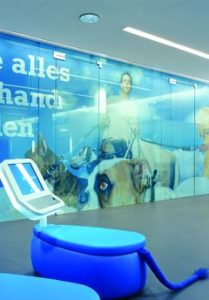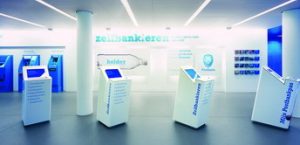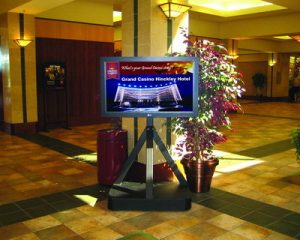It’s hard to imagine a set of digital signage projects more diverse than a high-end fashion salon, a casino complex and a Dutch bank. Nevertheless, there are a number of connecting threads among them that hold important lessons for what makes digital signage systems succeed or fail.
First, and most important, is the strategy. All the systems profiled in the following pages demonstrate the deployment of electronic messaging technology in the service of a clearly formulated goal. It bears repeating that this is quite different than deciding that owning a digital signage system would be a fine thing, but without having a clear objective for it to achieve.
In the case of Postbank, the implementation of different types of display and interactive technologies is leveraged to create a more “human” environment. The function of the Grand Casino systems is to deliver a range of messages as efficiently as possible, while also creating excitement in appropriate areas. And the long content loop in the Oddysée de Loft salon is a narrowcast engineered to support a fashion brand in a nimbus of lifestyle visuals.
It’s noteworthy that two of the three projects – the bank and the salon – were driven by multidisciplinary creative agencies equipped to coordinate the complex functionality of a technology-driven system within a consumer environment. Presumably, as more design firms develop skills in digital sign deployment, we will see more such systems that are seamless components of the space, rather than a postscript.
Postbank’s digital displays provide interactive services
Terms such as “personalized banking” have become popular in promotional language, suggesting that the individual customer is a meaningful entity (more than a number, if you will). Yet for the most part, the actual banking experience is antithetical to the marketing message.
Perhaps a more realistic solution may be experienced at a new Postbank branch store in Nijmegen, Netherlands. Designed jointly by Storeage and Dietwee agencies (both of Amsterdam), this banking environment is based on an acknowledgment that some customers seek human assistance, while others prefer to interface with devices.
The Postbank space is noticeably open, with a clear view of the interior from the glass front doors all the way to the rear. Right from the front door, the routes between employee-provided service on the left and self-service devices on the right are clearly defined in the simple, uncluttered layout. Reinforcing the suggestion of the floor plan, the functions of the sectors are spelled out by conventional signage: Questions and Answers on the human side, Self-Banking for the electronic side.
Near the entrance, a welcoming blue registration pod equipped with a 17-inch touchscreen is positioned at the corner of a blue carpet square. One can visit the pod or continue past. The registration kiosk asks two questions: Are you here for advice or financial transactions? The customer receives a queue number to speak with a human, depending on the answer. When the store isn’t busy, the kiosk also answers account inquiries.
Numerous other electronic displays and appliances are deployed throughout the Postbank branch. Four 26-inch, wall-mounted flat screens in the central area deliver a narrowcast program targeted at waiting customers. The content for the narrowcasting screens is generated by automatic feeds (news, weather, stock exchange info, local entertainment tips) and promotional messaging updated by Postbank monthly.
The self-service area houses standard ATMs and Internet-enabled kiosks. The latter feature a live web connection, which allows customers to conduct transactions and access their bank accounts in real time.
It’s a personal banking paradise, yet it pales in comparison with the two cool kid pods occupying the rear of the floor space. These custom-designed “cyber lions” are composed of three elements: a seat, an interactive display screen and … a tail (a nod to Postbank’s ubiquitous blue lion logo).
Not only do the kid pods entertain children, but they also to introduce them to finances and savings through an interactive game set in a fairy-tale landscape. The pods sit near the rear of the store by design, so parents can conduct their banking without worrying the kids will slip out the front door.
Grand Casinos’ digital signs offer immediacy
Casinos need to communicate a wide range of messages to a diverse clientele quickly, efficiently and within the extended confines of their property. And if you’re talking bang for the buck – as casinos almost always do – it’s almost as if electronic sign technology was developed for the gaming industry.
With an eye toward leveraging these advantages, Grand Casinos of Minnetonka, Minn., has installed large digital signage networks in its Mille Lacs and Hinckley casino resorts. Powered by software from Wireless Ronin Technologies (Minneapolis) and delivered by wireless network, the project now includes approximately 40 NEC LCD screens divided between the two properties.
Depending on the location, the screens range from 32- to 46-inch formats. At each display, content is broadcast on a standard PC loaded with RoninCast media player software. At the Hinckley casino, the property’s DMX sound system can also be incorporated into the electronic presentation.
Because content is distributed via WiFi wireless network, the casino benefits from a physical flexibility that would be constrained by the limitations of LAN cabling. In practice, this means new screens can be added or redeployed quickly throughout the properties, when changing conditions require it.
The Grand Casino installation provides a workman-like example of how content management software is critical to large systems. Among the components of the RoninCast software are modules for network management, schedule building and a database controller. The network manager allows the casino to deliver whatever type of content it wishes to any screen at any time. For example, the presentations differ dramatically in the gaming areas versus, say, the meeting rooms. It also facilitates the insertion of personalized video bits, such as “What’s Your Grand Casino Story?”, into the mix to convey immediacy. Jackpot winners can be announced in real time and share their adventures on screen.
The schedule-builder software component automates the entertainment and promotional calendar so that key events are announced with plenty of lead time. Similarly, the database feature generates automatic updates for changeable information such as weather, news, menu pricing and ticket availability.
Furthermore, the database can generate thrills via software written for the casino by Ronin. This custom code connects the database client to the casino’s proprietary gaming software – in this case, direct to the latest data for progressive jackpot pricing. When the playlist queues up the content for the progressive jackpot promo, it pulls current numbers directly from the casino system and displays them in real time on the network, building excitement as the jackpot rises. This is also tied to Grand Casino’s marketing program and regional television advertising.
Grand Casino generates and manages content with in-house creative personnel. Because the RoninCast system does not include any proprietary content-creation tool, the staff is free to use mainstream applications to generate standard multimedia files, including Flash, video, GIFs and JPEGs.
In the future, Grand Casino expects to replace backlit images on slot machine endcaps with flatscreen displays tied into the network system (a fairly easy process in a wireless environment). If you remember when a backlit display was considered high end, this prospect places things in a whole new perspective.
Odyssée salon system mixes local and global content
When Guez Communication and Design (Montreal) began to plan the digital signage network for Montreal’s Odyssée Salon, one thing it didn’t need to worry about was the length of the content loop. With the exception of two screens directed to passersby outside the store, the 15-screen in-store multimedia system is primarily viewed by customers seated for extended periods in styling chairs or waiting areas. No grabbing the attention of a distracted and peripatetic shopper here. The Odyssée le Loft & Spa sign system is more like a pure narrowcasting network, delivering a more-focused 85-minute presentation hand-crafted for a select but captive audience.
Although Odyssée is an independent salon, it’s also a member of Redken Canada’s salon family, and the electronic sign system integrated into the Odyssée salon program is essentially a dedicated channel in the Redken’s network. The Odyssée program loop includes Guez-produced multimedia programming combining both Redken-related and general multimedia content mixed from eight theme tracks: Redken events; Redken worldwide; Redken style gallery; Redken products; Redken innovations/product of the month; culture, art, trends, architecture and lifestyles; fashion files and salon/local info.
The content is hosted on the Paris servers of Mirane, a French digital signage software and services provider; delivered by broadband; and scheduled using Mirane’s “Mpact” content-management software. The broadcast may be managed according to location, client demography, season, promotional opportunities and special events. Content for the two screens with exterior exposure is managed separately due to copyright considerations.
Guez creates multimedia content based in part on Redken-furnished visuals and graphics, which are then repurposed into dynamic videos and animations. Segments are also initiated in response to local cultural or fashion events, or based on customer input.
The thirteen 17-inch interior flat screens are strategically located to allow clients to watch comfortably while seated at styling stations or the tea bar. Guez also custom-designed the display screen support housings as flat, rectangular architectural elements extending laterally from columns or down from the ceiling.
Because the display casings are the same neutral color and material as the ceiling, columns and walls, the flat screens become a seamless part of the environment. Designed to contain two screens back-to-back, the custom housings are engineered to vent heat from the screens.


 Photo Gallery3 days ago
Photo Gallery3 days ago
 Headlines2 weeks ago
Headlines2 weeks ago
 Sector Spotlight2 weeks ago
Sector Spotlight2 weeks ago
 Headlines1 week ago
Headlines1 week ago
 Headlines4 days ago
Headlines4 days ago
 Headlines2 weeks ago
Headlines2 weeks ago
 Designer Dozen1 week ago
Designer Dozen1 week ago
 Headlines3 days ago
Headlines3 days ago











